Enviro EF2 User Manual

SHERWOOD INDUSTRIES ISAN ENVIRONMENTALLY RESPONSIBLE COMPANY. THIS MANUAL IS PRINTED ON RECYCLED PAPER.
PLEASE KEEP THESE INSTRUCTIONS FOR FUTURE REFERENCE
PELLET STOVE
EF2
Freestanding, Fireplace Insert
& Built-In Heater
OWNER’S MANUAL
PLEASE READ THIS ENTIRE MANUAL BEFORE INSTALLATION
AND USE OF THIS PELLET BURNING ROOM HEATER. FAILURE TO
FOLLOW THESE INSTRUCTIONS COULD RESULT IN PROPERTY
DAMAGE, BODILY INJURY, OR EVEN DEATH.
Contact your building or fire officials about restrictions and installation inspection requirements in your area.
EF-119

Table of Contents |
|
Introduction................................................................................................................................... |
3 |
Pellet Quality.......................................................................................................................... |
3 |
Rating Label Location.............................................................................................................. |
3 |
Important Safety Data............................................................................................................. |
4 |
Safety Warnings And Recommendations.................................................................................... |
4 |
Operating Instructions..................................................................................................................... |
6 |
Automatic Safety Features....................................................................................................... |
6 |
Slider/Damper Setting............................................................................................................. |
6 |
Operating Your Pellet Stove..................................................................................................... |
7 |
Turning Your Pellet Stove Off................................................................................................... |
7 |
Routine Cleaning and Maintenance................................................................................................... |
8 |
Installation................................................................................................................................... |
11 |
Deciding Where to Locate your Pellet Appliance...................................................................... |
11 |
Removing Pellet Stove From Pallet.......................................................................................... |
11 |
Dimensions - Freestanding..................................................................................................... |
12 |
Dimensions - Fireplace Insert and Built-In Heater..................................................................... |
12 |
Clearances to Combustibles - Freestanding.............................................................................. |
13 |
Clearances to Combustibles - Fireplace Insert.......................................................................... |
13 |
Clearances to Combustibles - Built-In Heater........................................................................... |
14 |
Pedestal Installation.............................................................................................................. |
14 |
Vent Termination Requirements.............................................................................................. |
15 |
Outside Fresh-Air Connection................................................................................................. |
16 |
Exhaust And Fresh Air Intake Locations.................................................................................. |
16 |
Mobile Home Installation - Freestanding................................................................................. |
17 |
Corner Through Wall Installation - Freestanding...................................................................... |
17 |
Horizontal Exhaust Through Wall Installation - Freestanding..................................................... |
18 |
Through Wall With Vertical Rise and Horizontal Termination Installation - Freestanding.............. |
19 |
Inside Vertical Installations - Freestanding............................................................................... |
20 |
Outside Vertical Installations - Freestanding............................................................................ |
20 |
Hearth Mount Installation - Freestanding................................................................................. |
21 |
Masonry Fireplace Installation - Fireplace Insert....................................................................... |
22 |
Installation For A Built-In Heater............................................................................................ |
24 |
Installation of Control Panel into Surround Panel - FPI and BIH................................................ |
24 |
Installation and Removal of The Surround Panels - FPI and BIH............................................... |
25 |
Slider/Damper Installation..................................................................................................... |
26 |
The Tube Scraper Rod........................................................................................................... |
26 |
Troubleshooting............................................................................................................................ |
27 |
Wiring Diagram............................................................................................................................. |
31 |
Parts List...................................................................................................................................... |
32 |
Parts List - Options........................................................................................................................ |
35 |
Parts Diagram - Components......................................................................................................... |
36 |
Parts Diagram - Steel.................................................................................................................... |
37 |
Warranty...................................................................................................................................... |
38 |
Installation Data Sheet.................................................................................................................. |
40 |
2

Introduction
PELLET QUALITY:
Pellet quality is important, please read the following:
Your enviro pellet stove has been designed to burn wood pellets only. Do not use any other type of fuel, as this will void any warranties stated in this manual.
The performance of your pellet stove is greatly affected by the type and quality of wood pellets being burned. As the heat output of various quality wood pellets differs, so will the performance and heat output of the pellet stove.
CAUTION: It is important to select and use only pellets that are dry and free of dirt or any impurities such as high salt content. Dirty fuel will adversely affect the operation and performance of the unit and will void the warranty. The Pellet Fuel Industries (P.F.I.) has established standards for wood pellet manufacturers. We recommend the use of pellets that meet or exceed these standards. Ask your dealer for a recommended pellet type.
P.F.I. PELLET STANDARDS:
Fines (fine particles)...... |
1% maximum through a 1/8” screen |
Bulk Density.................. |
40 pound per cubic foot minimum |
Size.............................. |
1⁄4” to 5/16” diameter 1⁄2 – 11⁄2” long maximum |
Ash Content.................. |
1% maximum (Premium grade) |
.................. |
3% maximum (Standard grade) |
Moisture Content........... |
8% maximum |
Heat Content................. |
approximately 8200 Btu per pound minimum |
ASH: The ash content of the fuel and operation of your stove will directly determine the frequency of cleaning. The use of high ash fuels may result in the stove needing to be cleaned daily. A low ash fuel may allow longer intervals between cleaning.
CLINKERING: [clinkers are silica (sand) or other impurities in the fuel that will form a hard mass during the burning process]. This hard mass will block the air flow through the Burn Pot Liner and affect the performance of the stove. Any fuel, even approved types, may tend to clinker. Check the Burn-Pot Liner daily to ensure that the holes are not blocked with clinkers. If they become blocked, remove the liner (when the unit is cold) and clean/scrape the clinkers out. Clean the holes with a small pointed object if required. Refer to the section Routine Cleaning and Maintenance.
PELLET FEED RATES: Due to different fuel densities and sizes, pellet feed rates may vary. This may require an adjustment to the slider damper setting or to the auger feed trim setting on low.
Since Sherwood Industries Ltd. has no control over the quality of pellets that you use, we assume no liability for your choice in wood pellets.
Store pellets at least 36” (1 m) away from the pellet stove.
RATING LABEL LOCATION:
Freestanding: The rating label is located on the inside of the hopper lid.
Insert: The rating label is located on the hopper cover.
3
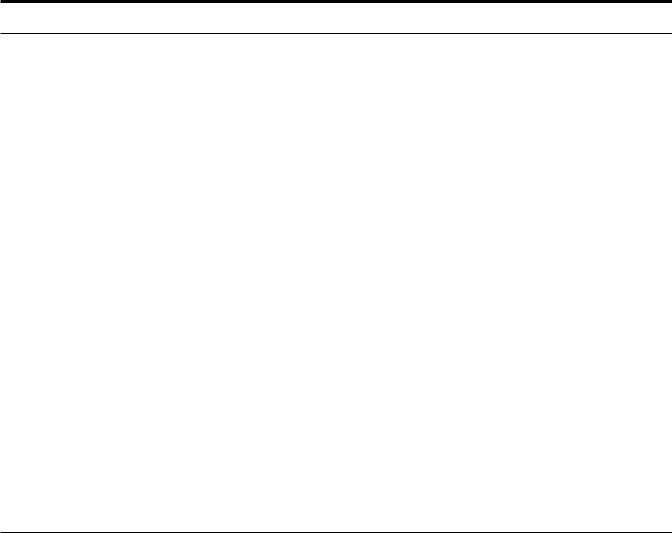
Introduction
IMPORTANT SAFETY DATA:
Please read this entire Owner’s Manual before installing or operating your ENVIRO Pellet Stove. Failure to follow these instructions may result in property damage, bodily injury or even death. Contact your local building or fire official to obtain a permit and any information on installation restrictions and inspection requirements for your area.
To prevent the possibility of a fire, ensure that the appliance is properly installed by adhering to the installation instructions. An ENVIRO dealer will be happy to assist you in obtaining information with regards to your local building codes and installation restrictions.
Be sure to maintain the structural integrity of the home when passing a vent through walls, ceilings, or roofs.
The stove’s exhaust system works with negative combustion chamber pressure and a slightly positive chimney pressure. It is very important to ensure that the exhaust system be sealed and airtight. The ash pan and viewing door must be locked securely for proper and safe operation of the pellet stove.
Do not burn with insufficient combustion air. A periodic check is recommended to ensure proper combustion air is admitted to the combustion chamber. Setting the proper combustion air is achieved by adjusting the slider damper located on the left side of the stove.
When installing the stove in a mobile home, it must be electrically grounded to the steel chassis of the home and bolted to the floor. Make sure that the structural integrity of the home is maintained and all construction meets local building codes.
Minor soot or creosote may accumulate when the stove is operated under incorrect conditions such as an extremely rich burn (black tipped, lazy orange flames).
If you have any questions with regard to your stove or the above-mentioned information, please feel free to contact your local dealer for further clarification and comments.
SAFETY WARNINGS AND RECOMMENDATIONS:
Caution: Do not connect to any air distribution duct or system.
Do not burn garbage or flammable fluids such as gasoline, naptha or engine oil. Unit hot while in operation. Keep children, clothing and furniture away. Contact may cause skin burns.
FUEL: This pellet stove is designed and approved to only burn wood pellet fuel with up to 3% ash content. Dirty fuel will adversely affect the operation and performance of the unit and may void the warranty. Check with your dealer for fuel recommendations.
THE USE OF CORDWOOD IS PROHIBITED BY LAW.
SOOT: Operation of the stove with insufficient combustion air will result in the formation of soot which will collect on the glass, the heat exchanger, the exhaust vent system, and may stain the outside of the house. This is a dangerous situation and is inefficient. Frequently check your stove and adjust the slider/ damper as needed to ensure proper combustion. See: “SLIDER/DAMPER SETTING”.
CLEANING: There will be some build up of fly ash and small amounts of creosote in the exhaust. This will vary due to the ash content of the fuel used and the operation of the stove. It is advisable to inspect and clean the exhaust vent semi-annually or every two tons of pellets.
4

Introduction
ASHES: Disposed ashes should be placed in a metal container with a tight fitting lid. The closed container of ashes should be on a non-combustible floor on the ground, well away from all combustible materials pending final disposal. If the ashes are disposed of by burial in soil or otherwise locally dispensed, they should be retained in the closed container until all cinders have been thoroughly cooled.
ELECTRICAL: The use of a surge protected power bar is recommended. The unit must be grounded. The grounded electrical cord should be connected to a standard 115 volts (3.9 Amps), 60 hertz electrical outlet. Be careful that the electrical cord is not trapped under the appliance and that it is clear of any hot surfaces or sharp edges and also must be accessible. If this power cord should become damaged, a replacement power cord must be purchased from the manufacture or a qualified ENVIRO dealer. The EF2’s maximum power requirement is 450 watts.
GLASS: Do not abuse the glass by striking or slamming the door. Do not attempt to operate the stove with broken glass. The stove uses ceramic glass. Replacement glass must be purchased from an ENVIRO dealer. Do not attempt to open the door and clean the glass while the unit is in operation or if glass is hot. To clean the glass, use a soft cotton cloth and mild window cleaner, gas or wood stove glass cleaner, or take a damp paper towel and dip into the fly ash. This is a very mild abrasive and will not damage the glass.
FLAMMABLE LIQUIDS: Never use gasoline, gasoline-type lantern fuel, kerosene, charcoal lighter fluid, or similar liquids to start or “freshen up” a fire in the heater. Keep all such liquids well away from the heater while it is in use.
SMOKE DETECTOR: Smoke detectors should be installed and maintained in the structure when installing and operating a pellet burning appliance.
OPERATION: The ash pan and door must be closed securely for proper and safe operation of the pellet stove. Also ensure all gaskets on the door are checked and replaced when necessary.
KEEP ASH PAN FREE OF RAW FUEL.
DO NOT PLACE UNBURNED OR NEW PELLET FUEL IN ASH PAN. A fire in the ash pan may occur.
INSTALLATION: Be sure to maintain the structural integrity of your home when passing a vent through walls, ceilings, or roofs. It is recommended that the unit be secured into its position in order to avoid any displacement.
DO NOT INSTALL A FLUE DAMPER IN THE EXHAUST VENTING SYSTEM OF THIS UNIT. DO NOT CONNECT THIS UNIT TO A CHIMNEY FLUE SERVING ANOTHER APPLIANCE.
FRESH AIR: Outside Fresh Air connection is optional. Must be connected to all units installed in Mobile and “Air Tight Homes” (R2000) or where required by local codes. Consider all large air moving devices when installing your unit and provide room air accordingly. Limited air for combustion may result in poor performance, smoking and other side effects of poor combustion.
If you have any questions with regards to your stove or the above-mentioned information, please feel free to contact your local dealer for further clarification and comments.
SINCE SHERWOOD INDUSTRIES LTD. HAS NO CONTROL OVER THE INSTALLATION OF YOUR STOVE, SHERWOOD INDUSTRIES LTD. GRANTS NO WARRANTY IMPLIED OR STATED FOR THE INSTALLATION OR MAINTENANCE OF YOUR STOVE. THEREFORE, SHERWOOD INDUSTRIES LTD. ASSUMES NO RESPONSIBILITY FOR ANY CONSEQUENTIAL DAMAGE(S).
SAVE THIS INSTRUCTION MANUAL FOR FUTURE REFERENCE
5
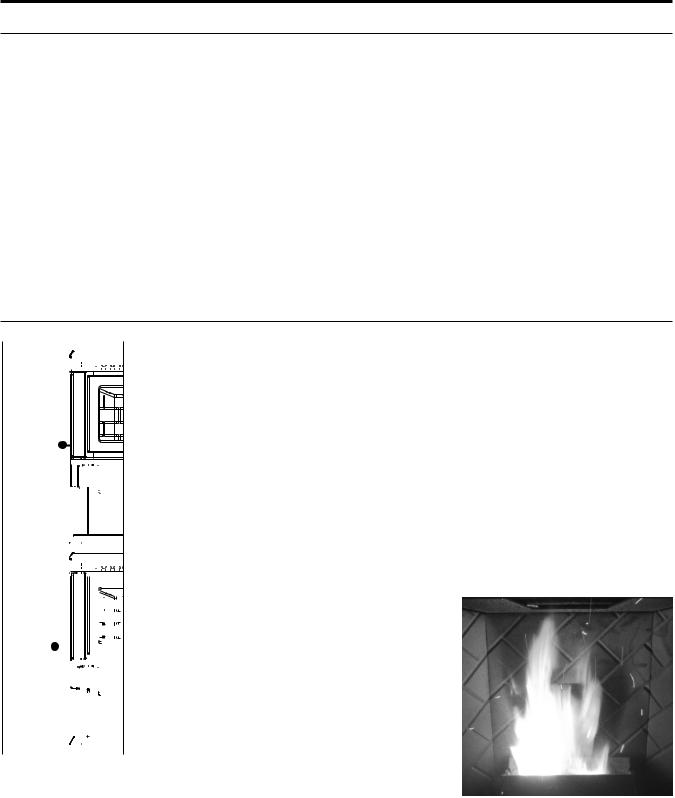
Operating Instructions
AUTOMATIC SAFETY FEATURES:
Your pellet Stove has the following safety features:
A.The stove will shut off when the fire goes out and the exhaust temperature drops below 120°F (49°C).
B.The stove has a high temperature safety switch. If the temperature on the hopper reaches 200°F (93°C), the auger will automatically stop and the stove will shut down when the exhaust temperature cools. If this happens, call your local dealer to reset the 200°F (93°C) high limit switch. ALSO FIND
THE REASONS WHY THE UNIT OVERHEATED.
C.The unit has a convection fan control over-ride. This function causes the convection fan to reach its full speed when the temperature at the back of the firebox reaches 160°F (71°C). This is a normal safety feature of your unit. To compensate for the fan cycling action that may occur, turn up the blower control proportionately to the heat output.
D.If the power goes out, the unit will stop running. When the power comes back on, the stove will not restart unless the exhaust temperature is still above 120°F (49 °C).
SLIDER/DAMPER SETTING:
 This is used to regulate the airflow through the pellet stove. A Qualified Service
This is used to regulate the airflow through the pellet stove. A Qualified Service 












 Technician or Installer should mark the slider rod in the current settings.
Technician or Installer should mark the slider rod in the current settings.
|
SPECIAL NOTES: |
|
Pellet quality is a major factor in how the Pellet stove will operate. If the pellets have |
|
a high moisture content or ash content the fire will be less efficient and has a higher |
|
|
|
possibility of the fire building up and creating clinkers (hard ash build-up). |

 If the fire should happen to go out and the Dial-A-Fire has been set on the lowest
If the fire should happen to go out and the Dial-A-Fire has been set on the lowest



 setting, the Slider Damper should be pushed in slightly, decreasing the air in the firebox or the Dial-A-Fire can be turned up slightly.
setting, the Slider Damper should be pushed in slightly, decreasing the air in the firebox or the Dial-A-Fire can be turned up slightly.
If, after long periods of burning, the fire builds up and overflows the burn pot or 
 there is a build up of clinkers, this would be a sign that the pellet quality is poor,
there is a build up of clinkers, this would be a sign that the pellet quality is poor, 












 this requires more primary air, the slider damper must be pulled out to compensate.
this requires more primary air, the slider damper must be pulled out to compensate.  Pulling the slider damper out gives the fire more air.
Pulling the slider damper out gives the fire more air.
|
|
|
|
|
The easiest way to make sure that an efficient |
|||||||
|
|
|
|
|||||||||
|
|
|
|
|
flame is achieved is to understand the |
|||||||
|
|
|
|
|
||||||||
|
|
|
|
|
characteristics of the fire. |
|||||||
|
|
|
|
|
|
|
|
|
|
|
||
|
|
|
|
|
|
|
|
|
|
|
||
|
|
|
|
|
|
|
|
|
|
|
||
|
|
|
|
|
|
|
|
|
|
|
• A tall, lazy flame with dark orange tips, requires |
|
|
|
|
|
|
|
|
|
|
|
|
||
|
|
|
|
|
|
|
|
|
|
|
more air – Open slider (pull out) slightly. |
|
|
|
|
|
|
|
|
|
|
|
|
• A short, brisk flame, like a blowtorch, has too |
|
|
|
|
|
|
|
|
|
|
|
|
much air – Close slider (push in) slightly. |
|
|
|
|
|
|
|
|
|
|
|
|
• If the flame is in the middle of these two |
|
|
|
|
|
|
|
|
|
|
|
|
||
|
|
|
|
|
|
|
|
|
|
|
characteristics with a bright yellow/orange, |
|
|
|
|
|
|
|
|
|
|
|
|
||
Figure 1: Slider / |
||||||||||||
active flame with no black tips then the air is |
||||||||||||
damper positions. |
set for proper operation, refer to Figure 2. |
|||||||||||
|
|
|
|
|
|
|
|
|
|
|
||
Taking a reading of vacuum pressure inside the firebox with a
magnehelic gauge can be used to set the slider for best combustion.
The best settings are a reading of 0.12 to 0.13 inches of water column (30 Pa) on the high fire setting. Some fuels may require higher or lower settings. The reading can be taken from the 1⁄8” (3 mm) hole located on the front of the unit below the door and behind the magnetic ash lip.
6
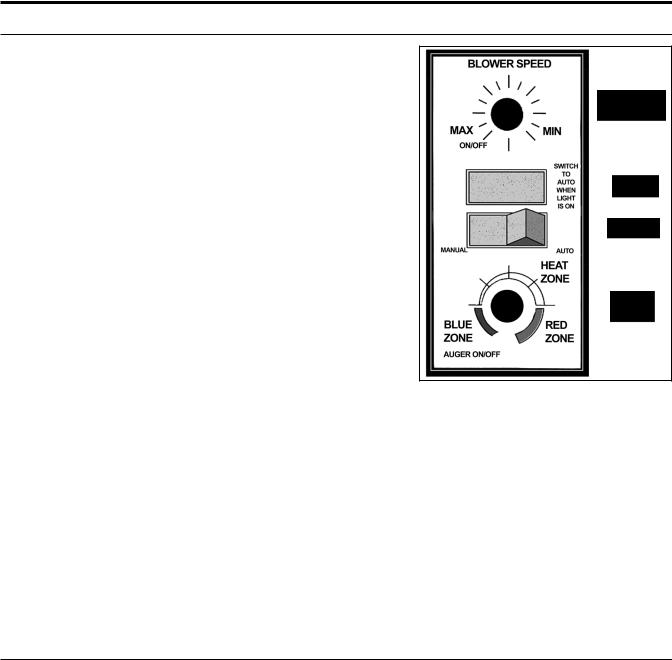
Operating Instructions
OPERATING YOUR PELLET STOVE:
1.Check and fill hopper with pellets.
2.Make sure unit is plugged into a working outlet.
3.Switch the power on by pushing the ROCKER SWITCH to the MANUAL position.
4.Turn KNOB B to the 12 o’clock position. (Lower grade pellets may need a higher setting on the feed rate). NOTE: Unit will take longer to light if the hopper has been completely emptied or is the first fire up.
5.Approximately fifteen (15) minutes after the fire was lit, the GREEN LIGHT should come on. When the GREEN LIGHT comes on, push the ROCKER SWITCH to the AUTO
position. Now the stove will shut-off automatically if the fire goes out.
6.Wait until the fire is established, then turn KNOB B to the desired heat output. The stove may not be able to burn in the BLUE ZONE if poor quality wood pellets are being used. Adjust the slider-damper to the appropriate setting (see
“SLIDER/DAMPER SETTING” section.
Figure 3: Dial-A-Fire control panel.
KNOB “A”: Fan Controller. By adjusting the knob you will vary the rate of airflow into the room by varying the speed of the convection blower. When you first start the stove, it should be placed in the “OFF” position in order to heat the unit as quickly as possible. Once the room has come up to temperature, the control may be set to a comfortable level. *Note: The convection blower may cycle to high automatically depending on the setting of KNOBS A and B. This is a normal safety feature of the unit.
KNOB “B”: Dia-A-Fire Heat Output Knob. This knob controls the amount of heat output. The dial has a scale with the blue zone representing the coolest setting of the stove, and the red zone representing the hottest setting. The scale on knob “B” represents a range, not exact at times or fuel quantities.
Wood pellets of differing quality may affect the performance of the stove. If the stove has trouble operating at either end of its range, turn the heat output knob back slightly.
TURNING YOUR PELLET STOVE OFF:
The AUTO/MANUAL SWITCH must be in the AUTO position during operation. To turn the stove off, simply turn the HEAT OUTPUT knob (KNOB B) counter-clockwise until the knob clicks to the “OFF” position. This will stop the feed of pellets. The blowers will continue to run and cool the stove.
SPECIAL NOTES:
If the stove is left in the manual mode after the green light comes on, the auger will continue to feed pellets. Pellets may over flow the burn-pot after the fire goes out and also re-light.
The scale on KNOB B represents a range, not exact times. Wood pellets of differing quality may effect the performance and/or the heat output of the stove. If the stove has trouble operating at the end of its range, adjust the heat output knob back slightly.
7

Routine Cleaning and Maintenance
NOTE: Do not use abrasive cleaners to clean the surface or any part of the stove.
The following should be inspected periodically to ensure that the appliance is operating at its optimum and giving you excellent heat value:
2-3 Days / Weekly |
Biannually or 2 Tons of Fuel |
Burn Pot and Liner |
Exhaust Vent |
Ash Pan |
Fresh air Intake Tube |
Inside Firebox |
Blower Mechanisms |
Door Glass |
Heat exchanger tubes |
Heat exchanger tubes |
Behind firebox liners |
Ash pan & Door gaskets |
All Hinges |
Door Latch |
Post Season Clean-up |
BURN POT AND LINER (2-3 days)
TOOLS REQUIRED TO CLEAN UNIT
•Torx T-20 Screwdriver
•5/16” Wrench or Socket,
•Brush,
•Soft Cloth
•Vacuum with fine filter bag
The following list of components should be inspected and maintained routinely to ensure that the appliance is operating at its optimum and giving you excellent heat value:
This is the ‘pot’ where the pellets are burned. The burn pot and liner should be inspected every two to three days, to ensure proper air flow through the liner. Failure to keep the liner clean may cause a build up of fuel past the burn pot liner and up the drop tube. This will cause the auger to jam and may result in pellets burning in the drop tube and hopper.
Ensure the unit is cold before cleaning. To remove the burn pot and burn pot liner, open the door using the door handle provided, located on the left-hand side of the stove. Swing the door open. Lift the liner from the burn pot. Lift the burn pot from the firebox by gently lifting the front of the burn pot up first, then sliding the assembly from the air intake tube and the ignitor cartridge. Using a metal scraper, remove material that has accumulated or is clogging the liner’s holes. Then dispose of the scrapped ashes from the liner and from inside the burn pot. Place the burn pot back into the stove, making sure that the pipes are properly inserted into the burn pot and the front tabs are placed in the firebox. Place the liner back into the burn-pot making sure that the ignitor hole in the liner is aligned with the ignitor tube. Push the liner up against the ignitor tube.
● If, after long periods of burning, the fire continually builds up and overflows the burn pot or there is a build up of clinkers, this is an indication that the pellet fuel quality is poor or the stove may need cleaning. Check the stove for ash build up (clean if required) and adjust the slider / damper to produce the proper clean combustion.


|
|
|
|
||
|
Figure 4: Burn pot with liner.
INSIDE FIREBOX (2-3 days)
For bi-weekly clean out, ash may be removed from behind the steel plates by rotating the circular cover to allow vacuuming behind the plates.
ASH PAN AND DOOR GASKETS (weekly)
After extended use the gasket may come loose. To repair or replace this, glue the gasket on, using hightemperature fiberglass gasket glue available from your local ENVIRO dealer. This is important to maintain an airtight assembly.
8
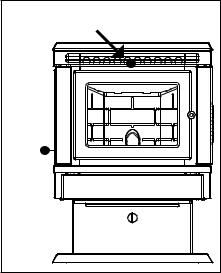
Routine Cleaning and Maintenance
ASH PAN (2-3 days)
Monitor the ash level every week. Remember that different pellet fuels will have different ash contents. Ash content is a good indication of fuel efficiency and quality. Dump the ashes into a metal container stored away from combustibles. Refer to “Warnings and Recommendations” for disposal of ashes. DO
NOT PLACE UNBURNED OR RAW PELLET FUEL IN ASH PAN.
Vacuum the ash pan and inside the pedestal. CAUTION: BECAUSE THE FLY ASH IS VERY FINE, THE USE OF A FINE FILTER VACUUM BAG WILL BE REQUIRED TO PREVENT ASH FROM BEING BLOWN BACK INTO THE ROOM. Please pay special attention that there are no hot ashes in the firebox or there could be a possibility of a fire hazard inside the vacuum cleaner. Place all hot ashes into a non-combustible container.
FREESTANDING ASH PAN:
The EF2 pellet stove freestanding’s ash pan is located under the burner, in the pedestal, and has a latching mechanism to secure it. To remove the ash pan, unlock the latch on the ash pan and then pull the pan out.
FIREPLACE INSERT AND BUILT-IN HEATER ASH PAN:
The EF2 pellet stove insert’s ash pan is located behind the lower grill.
HEAT EXCHANGER TUBES (2-3 days)
The handle for the heat exchanger cleaning rod is pointed out in Figure 5. This handle is to be pulled back and forth a few times
(ONLY WHEN THE UNIT IS COLD) in order to clean away any fly ash that may have collected on the heat exchanger tubes. As different types of pellets produce different amounts of ash, cleaning of the tubes should be done on a regular basis to enable the unit to run efficiently.
FRESH AIR INTAKE (season)
Inspect periodically to be sure that it is not clogged with any foreign materials.
Heat exchange |
tube cleaner rod |
Figure 5: EF2 Heat exchanger rod.
EXHAUST PASSAGES (season)
For bi-weekly clean out, ash may be removed from behind the steel plates by rotating the circular covers located behind the right and left side panels. Loosen the screw on the disks and open, this will allow vacuuming behind the firebox liner’s plates.
Removal of the firebox backing for bi-annual cleaning:
•Remove the top baffle.
•Lubricate and then remove the seven (7) screws that hold the brick liner in place. Tilt the top of the brick panel towards the firebox opening and remove from the firebox
•Remove the top rod by first removing the screw that holds it in place, then slide the rod sideways
•Pull the side panels into the center of the firebox, then out
•Pull the center panel out.
•Clean and vacuum all passages thoroughly.
9
Routine Cleaning and Maintenance
Installation of firebox backing:
•Install the side panels in place. Insert center panel, hold the panels in place
•Install the top rod by sliding it into one side panel then across into the other panel. Screw rod in place.
•Re-install steel brick liner and screw in place.
•Replace top baffle
EXHAUST VENT (season)
The products of combustion will contain small particles of flyash. The flyash will collect in the exhaust venting system and restrict the flow of the flue gases. Incomplete combustion, such as occurs during startup, shutdown, or incorrect operation of the room heater will lead to some soot formation which will collect in the exhaust venting system. The exhaust venting system should be inspected at least once every year or after two tons of pellets to determine if cleaning is necessary. We recommend contacting your dealer for professional cleaning. To remove dust from the vent pipe, tap lightly on the pipe to dislodge any loose ash. Open the bottom of the “T” to dump the ash, then vacuum as much of the ash out of the vent pipe as possible.
BLOWER MECHANISMS (season)
Unplug the stove then open the right and left side panels to access the two blowers. Vacuum all dust from motors. Only the convection blower motor (on the right side of the stove) will require lubrication. The convection motor has two lubrication holes on it. Use two drops of SAE 20 light oil to lubricate every six (6) months. Excess oil may damage the motor. The exhaust blower’s motor has sealed bearings, DO NOT lubricate this motor.
DOOR GLASS (It is recommended that your dealer replace the glass if broken.)
The door glass is made of 5 mm thick, high temperature PYROCERAMIC. To replace the glass, unscrew and remove the four glass retainers. Remove the glass and any broken pieces. High temperature fiberglass tape should be used around the glass. Replace the glass, center the glass assembly in the frame, then screw the glass retainers back to the frame. The use of substitute materials is prohibited use only part EF-061.
POST SEASON CLEAN-UP
Once you are finished using the pellet appliance for the season, unplug the stove for added electrical protection. It is very important that the stove be cleaned and serviced as stated above.
CLEANING PLATED SURFACES
Please clean all fingerprints off of all plated parts, with denatured alcohol on a soft cloth, before firing the unit each time. Fingerprints, etc. can become permanently etched into the plating if not removed before operating the pellet heater.
BRICK PANEL
The paint on the steel brick panel may peel. This is due to extreme conditions applied to the paint and is in no way covered by warranty.
10
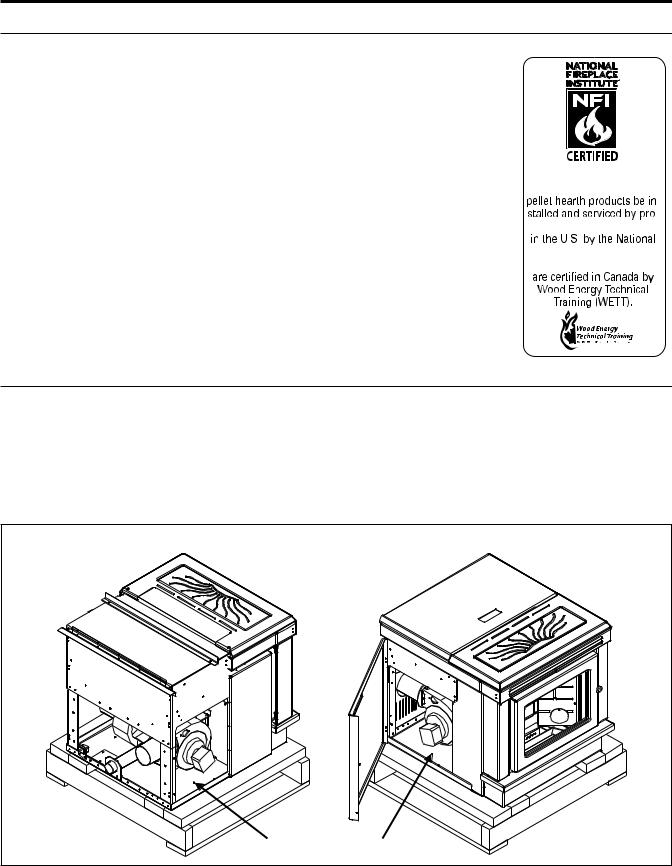
Installation
DECIDING WHERE TO LOCATE YOUR PELLET APPLIANCE:
1. Check clearances to combustibles.
2. Do not obtain combustion air from an attic, garage or any unventilated space. Combustion air may be obtained from a ventilated crawlspace.
3. Do not install the stove in a bedroom.
4. You can vent the stove through an exterior wall behind the unit or connect
it to an existing masonry or metal chimney (must be lined if the chimney is 






 over 6” (15 cm) diameter, or over 28 inches² (180 cm²) cross sectional area).
over 6” (15 cm) diameter, or over 28 inches² (180 cm²) cross sectional area). 







 An interior vent can be used with approved pipe passing through the ceiling
An interior vent can be used with approved pipe passing through the ceiling  and roof.
and roof. 











5. Locate the stove in a large and open room that is centrally located in the 










 house. This will optimize heat circulation.
house. This will optimize heat circulation. 











6. The power cord is 8 feet (2.43 m) long and may require a grounded extension cord to reach the nearest electrical outlet.
REMOVING PELLET STOVE FROM PALLET:
To remove your new stove from its pallet, open the left and right side panels. To open the side panels remove the ash pan cover from the magnets located below the door. Remove the two (2) T-20 screws located at the bottom corners of the left and right side panels. Remove the two (2) T-20 screws located between the hopper side rails and the side panels at the front edge of the side panel.
There are two (2) wood screws that are holding the bottom of the stove to the pallet. Remove the screws. Close the side panels. See “PEDESTAL INSTALLATION” to install the pedestal.
Fireplace Insert Model |
Freestanding |
|
Remove the screw here |
Figure 6: Screws to take out to remove stove from pallet.
11
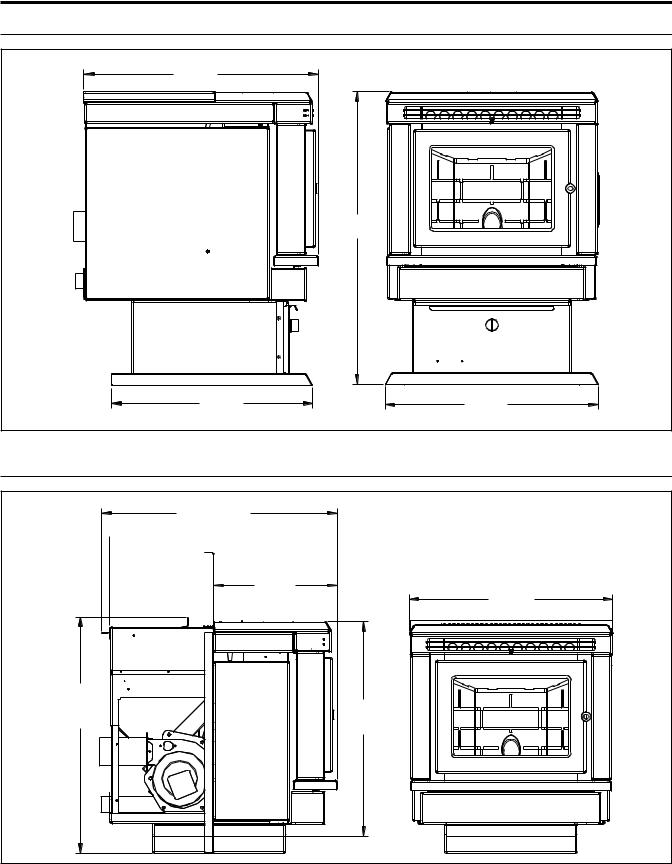
Installation
DIMENSIONS - FREESTANDING:
|
|
|
|
|
|
Figure 7: Dimensions of EF2 Freestanding.
DIMENSIONS - FIREPLACE INSERT AND BUILT-IN HEATER:


|
|
|
|
|
Figure 8: Dimensions of EF2 Fireplace Insert and Built-In Heater.
12
